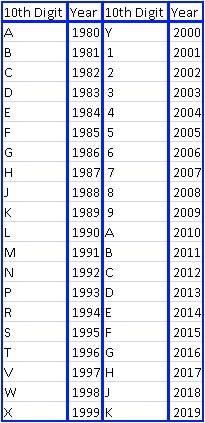- Home-icon
- શૈક્ષણિક સમાચાર (Educational News)
- _ઓનલાઈન શિક્ષણના વિડીયો (ONLINE EDUCATION VIDEOS)
- __ધોરણ 1 (ધોરણ ૧)
- __ધોરણ 2 (ધોરણ ૨)
- __ધોરણ 3 (ધોરણ ૩)
- __ધોરણ 4 (ધોરણ ૪)
- __ધોરણ 5 (ધોરણ ૫)
- __ધોરણ 6 (ધોરણ ૬)
- __ધોરણ 7 (ધોરણ ૭)
- __ધોરણ 8 (ધોરણ ૮)
- __ધોરણ 9 (ધોરણ ૯)
- __ધોરણ 10 (ધોરણ ૧૦)
- __ધોરણ 11 (ધોરણ ૧૧)
- __ધોરણ 12 (ધોરણ ૧૨)
- _Primary School (પ્રાથમિક શાળા સમાચાર)
- _Paripatra (ઉપયોગી પરીપત્રો)
- _Std 1 to 12 Text Books (ધોરણ ૧ થી ૧૨ના પાઠયપુસ્તકો)
- _LEARNING OUTCOMES (અધ્યયન નિષ્પતિઓ)
- _CCC EXAM MATERIALS (સીસીસી પરીક્ષા મટેરિયલ)
- નોકરી સમાચાર (JOBS NEWS)
- _Latest Jobs (નોકરીની હાલની જાહેરાતો)
- _MATERIALS (મટેરિયલ)
- _Call Letters/ Hall Tickets (કોલ લેટર /હોલ ટીકીટ)
- _ANSWER KEY (આન્સર કી)
- _Results (રીઝલ્ટ)
- HEALTH TIPS (આરોગ્ય હેલ્થ ટિપ્સ)
- LATEST ANDROID APPS (એન્ડ્રોઇડ એપ્લિકેશનનો ખજાનો)
- GOVERNMENT SCHEMES (સરકારી યોજનાઓ)
- ગુજરાતી વેબસાઈટ
Ticker
6/recent/ticker-posts
Understanding Vehicle Identification Numbers / "VIN Numbers"
VIN Number Decoding
Understanding Vehicle Identification Numbers / "VIN Numbers"

In the above video, we talk about "reading your VINs". It sounds pretty exciting right? That's because it is. A Vehicle Identification Number (VIN) is the 17-digit string of numbers that an automotive manufacturer assigns to a specific vehicle that it produces. You can find out a lot about your car or truck if you are able to read and decode its VIN number, and that's why we are going to show you how to do just that. Before 1981, there was not any standardization of VINs on American model cars and trucks. Vehicle manufacturers could have used 8 digits, 10 digits, 25 digits, or really whatever they wanted. So, to make America a better place, the National Highway Traffic Safety Administration put their foot down in 1981, and made all of the car manufacturers use 17 digits. Each number within that 17 digit VIN meant something specific about that car, well...except for one of those digits. We'll get into that later, though.
The letters I, O, and Q are not used in VINs, at least from 1981 until today (and into the future). That's because they get easily confused with the numbers one, and zero. Before we go any further on this automotive journey, I think we need to briefly talk about redundancy. I realize that saying "Vehicle Identification Number...Number" is silly, but it sure rolls off the tongue easier (fingers too). So, you may see "VIN Number" throughout this page, even though it is totally redundant. In the real world, that is how people say it, and being a real person (not a robot like many others), well you get the point. Okay, where were we? For the tenth digit of the VIN number , they never used the letters U, or Z. Why? I'm not really sure, but the NHTSA decided it, and that's just the way it is.
The first 3 digits of the VIN are known as the "WMI", which is an acronym for "World Manufacturer Identifier". That encompasses the country of origin, the manufacturer, and the division that the vehicle is built for.
First: In the example above, the first digit (1) means "United States"; if it was "J", it would mean Japan. So this digit designates the country where the vehicle was made.
Second: The second digit of a VIN number is the manufacturer that made the vehicle. This doesn't necessarily mean the "make" of the car though, because companies like General Motors have many different divisions. They have Chevy, Buick, and GMC, along with many others. In the example above, the second VIN digit would mean "General Motors".
Third: The third digit is the division of the larger manufacturer. In the case of General Motors, the division would be the more specific Buick, Pontiac, Oldsmobile or whatever it is. So, in the example above, the "N" happens to mean "Chevy".
The fourth through the eighth digits combined, are called the "Attributes" of the VIN. They include things like safety, engine size, body style, and the series that the vehicle is.
Fourth: The fourth digit is safety, braking and suspension. So if you have a special option,heavy-duty truck with the eight lug wheels, or a towing package, this is the digit that will tell you "Hey this vehicle has a special suspension and brake package." It might also reference a specific safety restraint package, like if the vehicle had a two vs. eleven air bag option or something crazy like that.
Fifth: The fifth digit, in this case S, which is the series of the vehicle. In the 1980's for example, General Motors built full size trucks that were C and K series along with and R and V series. The C/K was a different body style than the R/V. The C and R were designations for two wheel drive. The K and V were designations for four wheel drive. The letters would be found in the fifth digit of the VIN on these trucks. It was/is important when ordering parts because a "1988 Chevy Truck" could mean a variety of things depending on what that letter is. In this picture above, we have S series, which happens to be an S10 series truck. There was also a "T" series at the same time.
Sixth & Seventh: The sixth digit, along with the seventh is the body style. So if the vehicle is a convertible, a two door, four door, or wagon, it is defined in these two digits.
Eighth: The eighth digit, in this case a Z, is one of my personal favorites. It's the engine size! So if you were to go to a junkyard, this digit is really helpful for vehicles that had two different engines during the same year. An S10 Truck or an S10 Blazer are perfect examples of this. Both of these trucks could have come with a 4.3 liter that was a Z series engine or a W series engine. Both engines were 4.3 Liter's, but they had different parts attached to them. Buying parts for these engines is always interesting and this digit is what makes it that way.
Ninth: The ninth digit is called a check digit. It is called a check digit because the purpose of it is to check the rest of the VIN number for legitimacy. This is done by putting the VIN digits through some complex math. At the end of the equation, hopefully come out with the number that is in the 9th spot. If it comes out as something other than that, you know that the VIN Number is made up.
Tenth: The tenth digit is the year, which is amazingly helpful if you're in a junkyard or showing off to your friends. You can easily figure out which years match up to which letters and which numbers with the simple handy dandy chart below. Print it out and throw it into your wallet. Someday, you will thank us. In today's example, the tenth digit is "M", so you dance over to the handy dandy chart, and see that "M" is 1991. Tada! This is great in a junkyard because you can walk up to a VIN number and say "Hey this is a VIN J, which means it's a 1988". Go ahead, try it out and impress your friends. Remember, 10th digit = year.

Eleventh: The eleventh digit is the manufacturing plant. As you can guess, that's where the vehicle is made! This doesn't often matter so much, unless you are talking about certain cars that have major followings. Corvettes are a great example. Many, many Corvettes were made in Bowling Green, Kentucky. There is even a museum there! So whenever you talk about Corvettes, Bowling Green inevitably comes up. The 11th digit of the VIN number is the one that confirms the plant at which the vehicle was built. It might be Lansing, Michigan; Detroit, Michigan; or somewhere in Illinois. Car manufacturers have plants all over the world.
The Last Six Digits: The last six digits are the production line numbers. Most vehicle manufacturers start with the number 100001 as a starting point. This is normally not a super important number as far as buying auto parts goes, unless you have one of thosevehicles that changed production specifications halfway through a production run. So, you might have a vehicle that had different mirrors if it was built in April of 2004, than if it were built in August of 2004. If you have one of those vehicles, you need to know where it was in the production line, which is where these last six digits become important.
In addition to VINs there are also a plethora of option codes located somewhere in the interior of every vehicle. Long ago, they used to be actual printed pieces of paper, that were stuffed into the seat springs. In modern cars, it is usually a printed sticker in the glove compartment, console, or trunk. When you combine the VIN number with the option codes, you get the entire genetic makeup of the vehicle from top to bottom.
The last thing worth noting is that some foreign car manufacturers switch around these VIN numbers slightly. On many Volkswagens for example, the 3rd through 8th digits are in a different order than the American brand cars and trucks. They still have the same VIN information, but in slightly different spots. Typically the engine, vehicle series, body type, restraint system, and model are the ones to watch out for. The country, make, check digit, year, plant, and serial number are usually in the same positions regardless of the vehicle manufacturer...
Now you know how to read and decode your car or truck's VIN number! Thanks for watching, and reading along....
GOOGLE AD
Contact form
Labels
- 11-12 science
- 1BHK HOME PLAN
- 2BHK HOME PLAN
- 360 VIEW
- 3BHK HOME PLAN
- 4BHK HOME PLAN
- 5G NETWORK
- 7th Pay Committee
- 8th CENTRAL PAY COMMITTEE
- 8th CPC
- AADHAR CARD
- adharcard
- ADHARDISE
- ADHYAYAN NISHPATIO
- ADMISSION
- ADSENSE
- AEI
- AFFILIATE MARKETING
- After Std 12th???
- age limit
- AGRICULTURE
- AI
- AIRTEL SCHEME
- ALL NEWS PAPERS
- AMAZON
- AMUL
- Android App
- Answer Key
- ANTI VIRUS APP
- APAAR CARD
- APAARCARD
- APL LIST
- APMC
- Application to Gov
- APPRENTICESHIP
- ARTICLE 35A
- ARTICLE 370
- ARTIFICIAL INTELLIGENCE
- ASTROLOGY
- ATM
- AUDIO
- AVAILABLE SEATS
- AYODHYA CASE
- AYURVEDIC
- Baby Names
- bad
- BAL SHRUSHTI MAGAZINE
- BALVATIKA
- BANK
- BAOU
- BIRDS VOICE
- bisag
- BLO
- Blue Print
- BOOK
- BPL LIST
- BSF
- BSNL
- BUDGET
- BUSINESS NEWS
- Calculators
- CALENDAR
- call letter
- Call Letters
- CAMPAIGN
- CAR ON RENT IN INDIA
- CASH BACK
- cbse
- CBT
- ccc
- CCC EXAM MATERIAL
- CCC+
- CCE
- Central Government
- CET
- CGL
- CGPA
- CHARGER
- CHAT GPT
- CIRCULAR
- CISF
- CLAT
- Clerk
- CMAT
- CNG
- COAST GUARD
- Computer
- CONSTITUTION
- CORONAVIRUS
- COURT
- CPF
- CRC-BRC
- CREDIT
- CRICKET
- CRPF
- CRYPTO CURRENCY
- CTET
- CURRENCY
- current
- CYCLONE
- D.EL.ED.
- DA
- DAILY CURRENT AFFAIRS
- DAYARO
- DEBIT CARD
- DEFENCE
- DEPARTMENTAL EXAM
- DEVOTIONAL
- DGVCL
- Dictionary
- DIGITAL GUJARAT
- Digital India
- Digital Locker Service
- DIKSHA APP
- DIPLOMA
- Disaster Management
- DISE CODE
- DISTANCE LEARNING
- DIVYANG
- DOCUMENT VERIFICATION
- DONATE CAR TO CHARITY CALIFORNIA
- DRAWING
- Driving licence
- E-MAGAZINE
- EARN MONEY ONLINE
- EBC
- Eclipse
- ECONOMICS
- Education Department
- education of Out States
- EDUCATIONAL NEWS
- EDUSAFAR
- ele
- ELECTION
- ELECTRIC EQUIPMENT
- ELECTRIC VEHICLES
- english
- EPF
- ESSAY
- EXAM DATE
- excel
- EXTERNAL EDUCATION
- FEE PAYMENT
- FEE REFUND
- Festival
- fic
- FILE
- FINAL ANSWER KEY
- Finance Dept
- FIT INDIA
- fix pay
- FIXED DEPOSIT
- FLIPKART
- FLN
- FLOOD
- font
- FOREST
- form
- G-SHALA APP
- GAD
- GADGET
- game
- GAS
- GATE
- GCERT
- GEOGRAPHY
- GEOMETRY
- geovernment scheme
- GET DAILY MESSAGE
- GETCO
- GHARE SHIKHIYE
- GHIBLI IMAGE
- Gift City
- GIRNAR PARIKRAMA
- Gk
- GMAIL
- Gold-Silver Price
- government Employees
- government scheme
- GPAT
- GPF
- GPS
- GPSC
- GPSC DAILY UPDATES
- GPSSB
- GR
- GRADE PAY
- GRADUITY
- GRAMMAR
- GRANT
- GRAPH
- GREENHOUSE
- GSEB
- GSEBESERVICE
- GSET
- GSRTC
- gssb
- GSSSB
- GST
- GUEEDC
- GUJARAT PAKSHIK
- GUJARAT TOURISM
- GUJARAT UNIVERSITY
- gujarati
- gujcet
- gunotsav
- GYAN KUNJ
- GYAN SADHANA
- GYAN SAHAYAK
- GyanParab
- GYANSETU
- GYANSETU SCHOOL
- GYANSHAKTI SCHOOL
- HACKING
- Hair Problem
- hall ticket
- HANTAVIRUS
- HEALTH DEPARTMENT
- HEALTH TIPS
- Help Line
- HERITAGE
- HETUO
- HIGH COURT
- HIGHER PAY SCALE
- Hindi
- HISTORY
- HITESHPATELMODASA
- HMAT
- HNGU
- HOLIDAYS
- HOME LEARNING
- HOME LOAN
- HOROSCOPE
- HOSPITAL JOBS
- HOSTEL
- HOW TO
- HRA
- HSC
- HTAT
- I KHEDUT YOJANA
- IBPS
- ICDS
- ICE RAJKOT
- IELTS
- IIM
- IIT
- IJAFO
- income tax
- INCREMENT
- INDIAN AIR FORCE
- Indian Army
- INDIAN COAST GUARD
- Indian Navy
- Inspire Award
- insurance
- Internet
- interview
- INVESTMENT
- IPHONE
- IPL
- IPO
- ISRO
- ITI
- JAM
- Javahar Navodaya
- JEE
- Jilla Fer Badali
- JIO
- JIOGIGAFIBER
- job
- JRF
- JYOTISH
- KENDRIYA VIDYALAYA
- KGBV
- KHADI
- KHEDUT
- KHEL SAHAYAK
- KHELMAHAKUMBH
- KIDS
- Language
- LATEST MOBILE
- LC
- LEARNING OUTCOMES
- LIC
- LIVE DARSHAN
- LIVE TELECAST
- LOANS
- LOCKDOWN
- LOGBOOK
- LOGO
- LOKSABHA
- LPG
- LTC
- MAHABHARAT
- MAHEKAM
- MAPS
- MARI YOJANA WEBSITE
- MARUGUJARAT
- MASIK PATRAK
- MASVAR AAYOJAN
- MATDAR YADI
- MATERIAL
- Mathematics
- MATHS-SCIENCE KIT
- MATRUTVA RAJAO
- MDM
- MDRA BILL MERA ADHIKAR
- MEDIA
- medicine
- MEDITATION
- MEENA RADIO
- MERIT
- Mesothelioma
- META
- MGVCL
- MICROSOFT
- MINA NI DUNIYA
- MISSION VIDHYA
- Mob Restrict
- MOBILE
- MODEL PAPERS
- model school
- MODULE
- MONGHVARI
- MORTGAGE
- MOVIE
- MP3
- MRP
- MS UNIVERSITY
- MUSIC
- MUTUAL FUND
- My Article
- MYSY
- Nagarpalika Jobs
- NAMO LAKSHMI YOJANA
- NARENDRA MODI
- NAS
- NATAK
- National Highways
- NCERT
- NDA
- NEET
- NEP 2020
- NET
- NEW EDUCATION POLICY
- New Jobs
- NEWS
- NFSA
- NIBANDH
- NMMS
- NOKIA
- notification
- NPS
- NREGA
- NTSE
- NURSING
- OBC
- OJAS JOBS
- old papers
- OMRSHEER
- ONGC
- ONLINE ATTENDANCE
- ONLINE BILL PAYMENT
- ONLINE BOOKING
- Online Material
- ONLINE SHOPPING
- ONLINE TEACHER TRANSFER
- OROP
- PAGAR BILL
- PAN
- panchayat
- paper solution
- Pari
- PARIKSHA AAYOJAN
- PARIKSHA PE CHARCHA
- Paripatra
- Pass
- PASSPORT
- PAT
- patrako
- PAY SCALE
- PAYTM
- PEDAGOGY
- Penshan
- PERCENTILE RANK
- PET
- PETROL-DIESEL-LPG PRICE
- PFMS
- PGVCL
- PH
- PhD
- PITRUTVA RAJAO
- PM AWAS YOJANA
- PM CARES FUND
- PM Kisan Samman Nidhi
- PM WANI SCHEME
- PM YASHASVI Scolarship Scheme
- PM-JAY
- PMMVY
- PMSYM
- POEMS
- police
- POLITICAL NEWS
- Post Office
- PRADHAN MANTRI SHRAM YOGI MAN DHAN YOJANA
- pragya
- PRAPTA RAJA
- PRATIBHASHALI VIDHYARTHI
- Pravasi Shixak
- Praveshotsav
- PRAYER
- PRESS NOTE
- PRET
- PRIMARY SCHOOL
- PROVISIONAL ANSWER KEY
- PSE-SSE
- PSYCHOLOGY
- PTC
- PUC CERTIFICATE
- PUZZLES
- QR CODE
- QUIZ
- railway
- RAILWAY RECRUITMENT
- RAJAO
- RAKSHASHAKTI SCHOOL
- RAM MANDIR
- Ramayan
- RATH YATRA 2018
- RATIONCARD
- RBI
- READING CAMPAIGN
- RECHARGE
- REDMI
- Reservation
- result
- Results
- REVIEW
- REWARD
- RINGTONE
- RIP
- Rojagar
- Rojagar News Paper
- ROJNISHI
- RRB AHMEDABAD
- RTE
- RTI
- RTO
- SAINIK SCHOOL
- SALANG NOKARI
- SAMARTH
- sangh
- SANSKRIT
- SARKARI YOJANA
- SAS GUJARAT
- SBI
- SC
- SCE
- Scholarship
- SCHOOL JOBS
- SCHOOL MERGE
- SCHOOL OF EXCELLENCE
- science
- SEB
- secondary school
- SELECTION LIST
- SELL
- Service Book
- SHALAKOSH
- SHARE MARKET
- Shikshan Sahayak
- SHIXAK JYOT
- SI
- SOE
- SOFTWARE
- SOLAR ENERGY
- Song
- SPEECH
- SPELLING
- SPIPA
- SPORT
- SS
- SSA
- SSC
- STAFF SELECTION COMMISSION
- STANDARD-1
- STANDARD-10
- STANDARD-11
- STANDARD-12
- STANDARD-2
- STANDARD-3
- STANDARD-4
- STANDARD-5
- STANDARD-6
- STANDARD-7
- STANDARD-8
- STANDARD-9
- STEM LAB
- STORY
- SUBSIDY
- SUKANYA SAMRIDDHI YOJANA
- SUPREME COURT
- SURVEY
- Svachchh Bharat
- SWIFTCHAT
- syllabus
- TABLET YOJANA
- talati
- TALIM
- TALUKA FER BADALI
- TAT
- TEACHER EDITION
- Teacher Seniority List
- TEACHERS CODE
- TECHNOLOGY
- TET
- TEXT BOOKS STD: 1-12
- TIKTOK
- time table
- TOLL FREE NUMBERS
- TPEO-DPEO
- TPT
- True copy
- TV
- UGVCL
- UNIT TEST
- UNIVERSITY NEWS
- UPCHARATMAK KARYA
- UPSC
- USEFUL WEBSITES
- VAGLE
- VALATAR RAJA
- VANAGI
- VANCHAN ABHIYAN
- VANDE GUJARAT
- VASATI GANATRI
- VAVAZODU
- VI NEWS
- video
- VIDHYASAHAYAK BHARATI
- VIGYAN MELO
- VIKALP CAMP
- Vikas
- VIKRAM SARABHAI SCHOLARSHIP
- VINOD RAO
- VIRAL VIDEOS
- VIRTUAL CLASSROOM
- VITAMINS
- VOTER LIST
- WAITING LIST
- WATERPARKS
- weather
- WEATHER FORECAST
- WINDY
- WORLD CUP 2019
- WORLD'S LARGEST
- XIAOMI
- YOGA
- YOUTUBE
- हिन्दी
- ગ્રામર
- વ્યાકરણ
Random Posts
3/random/post-list
Recent in Jobs
3/job/post-list
Popular Posts
Created By VKTemplates | Distributed By Blogger Theme Developer









